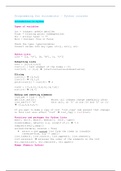Samenvatting
Summary Python courses programming for economists
- Instelling
- Tilburg University (UVT)
This is a summary of the "Python"-part of the course: Programming for economists given at Tilburg University. The documents contains a summary of the theory and codes needed to do the exercises in Python.
[Meer zien]




